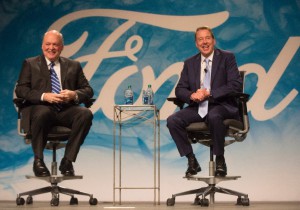He may have lost one of the top spots in the auto industry, but Mark Fields won’t go away empty-handed.
Ousted Ford Motor Co. CEO Mark Fields will receive a parting gift of as much as $57.5 million, according to a report by the Bloomberg news service, including pay, stock awards, retirement benefits and bonuses. That figure is expected to dwarf what his successor, Jim Hackett will make, at least during his first year at the helm of the second-largest U.S. automaker.
Officially, Fields resigned last Friday, though it was made clear to him that Ford Chairman – and the grandson of founder Henry Ford – Bill Ford Jr. was intent on replacing the 56-year-old company veteran with the 62-year-old Hackett, a former chief executive at Steelcase, the Michigan-based office furniture manufacturer.
Elevated to CEO in July 2014, Fields saw Ford’s profits hit an all-time record last year. But the maker’s sales and market share have been sliding, and earnings tumbled 38% during the first quarter of 2017, to $1.6 billion. What may have sealed his fate was the sharp decline in the carmaker’s stock price. It dropped 40% since Fields replaced his mentor Alan Mulally nearly three years ago.
(For more on Fields’ ouster, Click Here)
Ford’s stock rebounded slightly after Hackett’s appointment was announced but then resumed its months-long decline. At midday Friday, ahead of the long Memorial Day weekend, it was trading at $10.85 a share, just slightly ahead of its 52-week low.
The decline in Ford’s stock has hurt the payout Fields is expected to receive as he leaves Ford since the largest portion of his compensation will come from unvested stock awards. Those will continue to vest between now and 2020. At the current share price, the New York-born executive would receive around $29 million, but that could grow substantially if Hackett and his new, hand-picked management team can reverse the three-year slump in Ford stock.
Fields also will receive about $17.5 million in retirement benefits, according to Bloomberg data, stock options of around $8.1 million, and an estimated prorated incentive bonus of about $2.1 million.
Like most large corporations, Ford’s top executives, and especially its CEO, receive the lion’s share of their pay in stock and bonuses, rather than base pay. That approach, which gained traction over the last several decades, is meant to incentivize managers to run a lean and profitable ship, with a focus on the corporate share price. But critics have countered that this strategy often sees big swings up and then sudden sharp slumps, executives often focusing on short-term strategies that can boost their personal benefits, rather than ensure long-term corporate success.
(Management shake-up continues. Click Here to see how new CEO Hackett is reshaping Ford’s senior management team.)
Despite its poor performance on the stock market, Fields has benefited from Ford’s stronger earnings – at least through the most recent quarter. In 2016, his overall compensation rose 19%, to $22.1 million.
His going-away incentives will take several years to pay out. In the nearer term, Fields will continue to get “reasonable use” of Ford’s corporate aircraft, which operate out of the suburban Detroit Willow Run Airport, until August 1, the day his retirement officially takes effect. He will be eligible for additional, pro-rated bonuses and equity awards through that date.
(Who is new CEO Jim Hackett? Click Here to learn more.)
For his part, new CEO Jim Hackett will have to cinch his belt since his first-year payout will be far more modest, Ford valuing the potential compensation at around $13.4 million, including a $1.8 million base salary – double what he was getting for serving on the Ford board and running the company’s Mobility Services unit – an incentive plan bonus of up to $3.6 million, $7 million in restricted stock grants, and a $1 million accession bonus.
As with Fields, Hackett’s pay and bonuses are expected to rise over the next few years, especially if he can deliver improvements in sales, market share, earnings – and turn around Ford’s slumping stock price.


